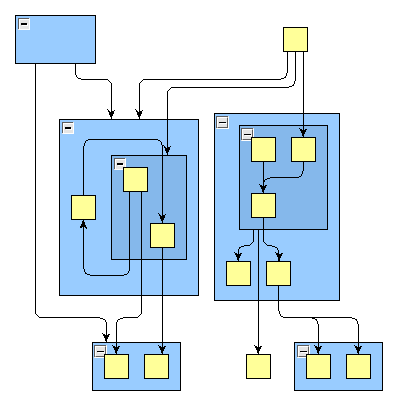 y.layout.CanonicMultiStageLayouter
y.layout.CanonicMultiStageLayouter
 y.layout.hierarchic.HierarchicLayouter
y.layout.hierarchic.HierarchicLayouter
 y.layout.hierarchic.HierarchicGroupLayouter
y.layout.hierarchic.HierarchicGroupLayouter
|
Search this API | ||||||||
| PREV CLASS NEXT CLASS | FRAMES NO FRAMES | ||||||||
| SUMMARY: NESTED | FIELD | CONSTR | METHOD | DETAIL: FIELD | CONSTR | METHOD | ||||||||
java.lang.Objecty.layout.CanonicMultiStageLayouter
y.layout.hierarchic.HierarchicLayouter
y.layout.hierarchic.HierarchicGroupLayouter
public class HierarchicGroupLayouter
This class is an extended variant of the HierarchicLayouter class. It is capable of laying out nested groups of nodes as well as the group nodes themselves. The grouping information is provided through DataProvider instances, which are registered with the LayoutGraph instance. The layout is being calculated recursively. The size of the group nodes is determined by the area occupied by the children of the group node.
Here is a sample output of the algorithm.
| Field Summary |
|---|
| Fields inherited from class y.layout.hierarchic.HierarchicLayouter |
|---|
LAYERING_BFS, LAYERING_FROM_SKETCH, LAYERING_HIERARCHICAL_DOWNSHIFT, LAYERING_HIERARCHICAL_OPTIMAL, LAYERING_HIERARCHICAL_TIGHT_TREE, LAYERING_HIERARCHICAL_TOPMOST, LAYERING_STRATEGY_UNKNOWN, LAYERING_USER_DEFINED, LINEAR_SEGMENTS, MEDIAN_SIMPLEX, PENDULUM, POLYLINE, ROUTE_ORTHOGONAL, ROUTE_POLYLINE, SIMPLEX, TREE |
| Fields inherited from interface y.layout.PortConstraintKeys |
|---|
SOURCE_GROUPID_KEY, SOURCE_PORT_CONSTRAINT_KEY, TARGET_GROUPID_KEY, TARGET_PORT_CONSTRAINT_KEY |
| Fields inherited from interface y.layout.Layouter |
|---|
EDGE_ID_DPKEY, NODE_ID_DPKEY, SELECTED_EDGES, SELECTED_NODES |
| Constructor Summary | |
|---|---|
HierarchicGroupLayouter()
Creates a new instance of HierarchicGroupLayouter |
|
| Method Summary | |
|---|---|
boolean |
canLayoutCore(LayoutGraph graph)
Returns true.. |
void |
doLayout(LayoutGraph graph)
Calculates a layout for the given graph. |
void |
doLayoutCore(LayoutGraph g)
Layouts the given graph. |
Drawer |
getDrawer()
Returns the drawer which is responsible for the third phase of the algorithm |
GroupBoundsCalculator |
getGroupBoundsCalculator()
Gets the current GroupBoundsCalculator instance. |
protected Grouping |
getGrouping()
Returns the associated Grouping instance. |
Layerer |
getLayerer()
Returns the Layerer, which is responsible for the first phase
of the algorithm. |
protected NodeList[] |
getLayerSequence(LayoutGraph g,
NodeMap LAYER_KEY,
int maxLayer)
Determines the order of the nodes within their layers. |
LayerSequencer |
getLayerSequencer()
Returns the LayerSequencer, which is responsible for the second phase
of the algorithm. |
boolean |
isGlobalSequencingActive()
Returns the current strategy for the node sequencing. |
boolean |
isStrongPortsScalingActive()
Gets the property strongPortsScalingActive. |
protected Rectangle2D |
layoutLevel(Node root,
NodeList levelNodes,
boolean buildGraphsOnly)
Layouts the children of root recursively. |
void |
setDrawer(Drawer drawer)
Sets the drawer which is responsible for the third phase of the algorithm. |
void |
setGlobalSequencingActive(boolean globalSequencingActive)
Determines whether a global sequencing heuristic should be used. |
void |
setGroupBoundsCalculator(GroupBoundsCalculator groupBoundsCalculator)
Sets the GroupBoundsCalculator instance. |
void |
setLayerer(Layerer layerer)
Sets the Layerer, which is responsible for the first phase
of the algorithm. |
void |
setLayeringStrategy(byte strategy)
Sets a predefined layering strategy. |
void |
setLayerSequencer(LayerSequencer sequencer)
Sets the LayerSequencer, which is responsible for the second phase
of the algorithm. |
void |
setLayoutStyle(byte style)
Sets the layout style for this layouter. |
void |
setStrongPortsScalingActive(boolean strongPortsScalingActive)
Sets the property strongPortsScalingActive. |
| Methods inherited from class java.lang.Object |
|---|
clone, equals, finalize, getClass, hashCode, notify, notifyAll, toString, wait, wait, wait |
| Constructor Detail |
|---|
public HierarchicGroupLayouter()
| Method Detail |
|---|
protected Grouping getGrouping()
Grouping instance.
public boolean canLayoutCore(LayoutGraph graph)
true..
canLayoutCore in class HierarchicLayouterpublic void doLayoutCore(LayoutGraph g)
doLayoutCore in class HierarchicLayouter
protected Rectangle2D layoutLevel(Node root,
NodeList levelNodes,
boolean buildGraphsOnly)
root - The current root node (parent, invisible during layout)levelNodes - The nodes to be laid out
public void doLayout(LayoutGraph graph)
CanonicMultiStageLayouter
doLayout in interface LayouterdoLayout in class CanonicMultiStageLayouterpublic void setLayerSequencer(LayerSequencer sequencer)
HierarchicLayouterLayerSequencer, which is responsible for the second phase
of the algorithm.
setLayerSequencer in class HierarchicLayouterpublic void setLayerer(Layerer layerer)
HierarchicLayouterLayerer, which is responsible for the first phase
of the algorithm.
setLayerer in class HierarchicLayouterpublic Layerer getLayerer()
HierarchicLayouterLayerer, which is responsible for the first phase
of the algorithm.
getLayerer in class HierarchicLayouterpublic LayerSequencer getLayerSequencer()
HierarchicLayouterLayerSequencer, which is responsible for the second phase
of the algorithm.
getLayerSequencer in class HierarchicLayouterpublic GroupBoundsCalculator getGroupBoundsCalculator()
public void setGroupBoundsCalculator(GroupBoundsCalculator groupBoundsCalculator)
groupBoundsCalculator - New GroupBoundsCalculator instance.public void setDrawer(Drawer drawer)
setDrawer in class HierarchicLayouterpublic Drawer getDrawer()
getDrawer in class HierarchicLayouterpublic void setLayoutStyle(byte style)
HierarchicLayouterHierarchicLayouter.POLYLINE, HierarchicLayouter.LINEAR_SEGMENTS, HierarchicLayouter.MEDIAN_SIMPLEX,
HierarchicLayouter.SIMPLEX, HierarchicLayouter.PENDULUM,
and HierarchicLayouter.TREE.
The default is set to HierarchicLayouter.LINEAR_SEGMENTS
setLayoutStyle in class HierarchicLayouterpublic void setLayeringStrategy(byte strategy)
HierarchicLayouterHierarchicLayouter.LAYERING_HIERARCHICAL_TIGHT_TREE is set.
setLayeringStrategy in class HierarchicLayouterstrategy - one of
HierarchicLayouter.LAYERING_HIERARCHICAL_TOPMOST, HierarchicLayouter.LAYERING_HIERARCHICAL_DOWNSHIFT,
HierarchicLayouter.LAYERING_HIERARCHICAL_TIGHT_TREE, HierarchicLayouter.LAYERING_HIERARCHICAL_OPTIMAL,
HierarchicLayouter.LAYERING_FROM_SKETCH, HierarchicLayouter.LAYERING_USER_DEFINED or
HierarchicLayouter.LAYERING_BFS.public boolean isStrongPortsScalingActive()
true.
public void setStrongPortsScalingActive(boolean strongPortsScalingActive)
true.
strongPortsScalingActive - the new value of the property.
protected NodeList[] getLayerSequence(LayoutGraph g,
NodeMap LAYER_KEY,
int maxLayer)
HierarchicLayouter
getLayerSequence in class HierarchicLayouterpublic boolean isGlobalSequencingActive()
public void setGlobalSequencingActive(boolean globalSequencingActive)
globalSequencingActive - the new value.
|
© Copyright 2000-2013, yWorks GmbH. All rights reserved. |
||||||||
| PREV CLASS NEXT CLASS | FRAMES NO FRAMES | ||||||||
| SUMMARY: NESTED | FIELD | CONSTR | METHOD | DETAIL: FIELD | CONSTR | METHOD | ||||||||